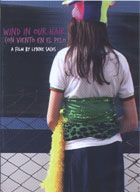
Wind in Our Hair / Con Viento en el Pelo 2011
Distributed by Microcinema International/Microcinema DVD, 2169 Folsom Street, Suite M101, San Francisco, CA 94110; 415-447-9750
Producer n/a
Directed by Lynne Sachs
DVD, color and b&w, 54 min.
College - General Adult
Film Studies
Date Entered: 03/14/2012
Reviewed by Oksana Dykyj, Head, Visual Media Resources, Concordia University, MontrealLynne Sachs presents another experimental film collection, featuring her daughters Maya and Noa. Wind in Our Hair is loosely inspired by 2 short stories by Julio Cortazar from the 1950s but set in contemporary Buenos Aires. A group of lively young girls frolic and interact with their urban environment. They playfully horse around in the kitchen while a puppy tries to join in, they go to playgrounds, and they play dress up. All the while the soundtrack either provides a very studied, formally read narration by one of the girls or a kind of contrapuntal radio news narration contextualizing the politics of protests and strikes in Buenos Aires. We become privy to their thoughts and their lives. The last sequence of the film has a nostalgic 8-millimeter home movie look about it, as if it were shot with frantic abandon by one of the girls, often out of focus but powerful as some home-movies can be. The look of the film is completely inconsistent, but perfectly understandable since it was shot by five different individuals and ostensibly five different approaches and styles. Some are concerned with shakily moving the camera, others with attempting to focus in on close-ups. The film ends up having a kind of patchwork elegance despite itself.
The two other films are short mostly silent films of the two daughters. The first one is a silent slow motion black and white film of Maya running around in circles and the second film is a collage of disparate snippets of silent and sound footage of Noa. Both films are a mother’s loving present to her daughters. Recommended for the study of experimental narrative films.